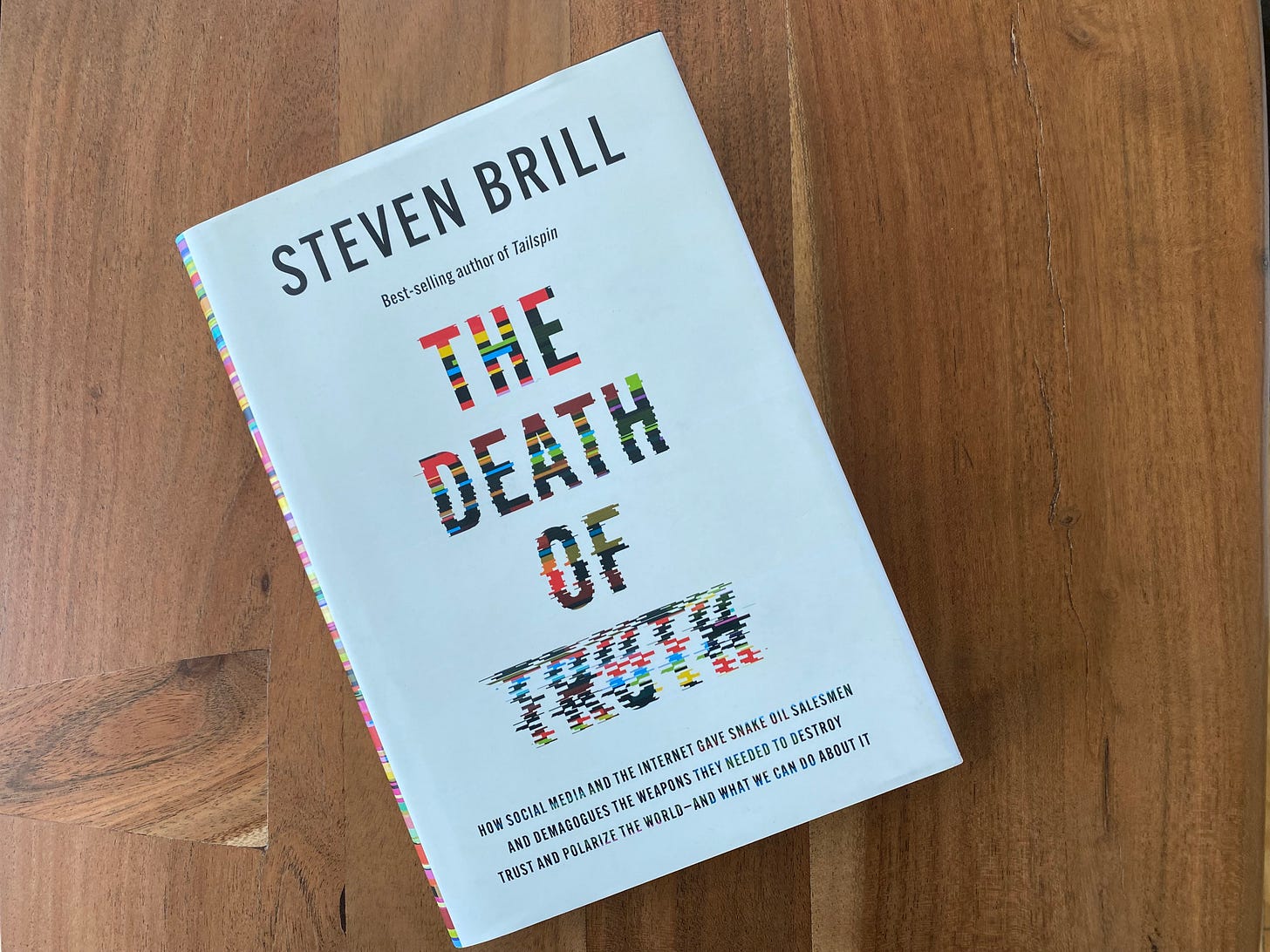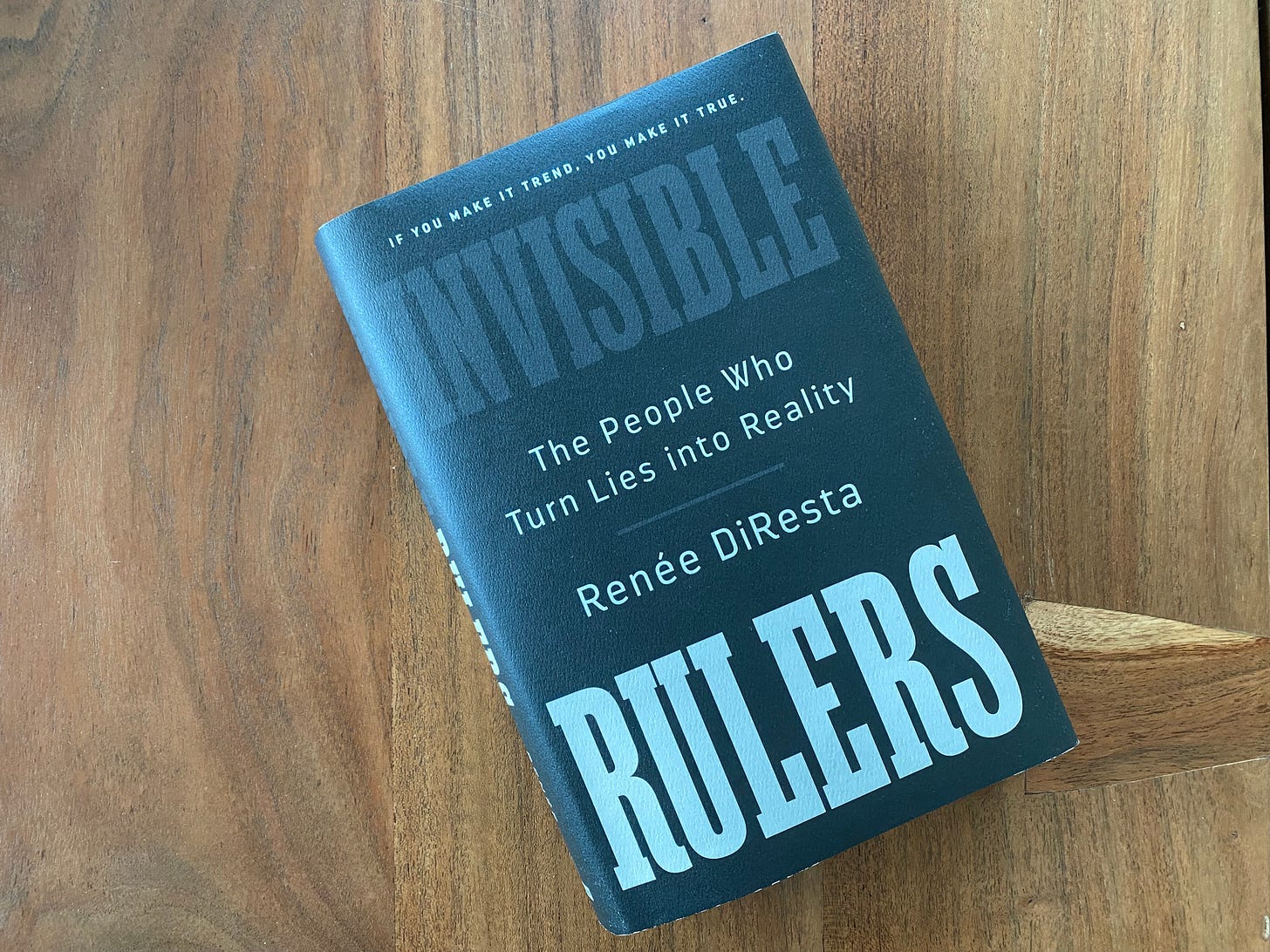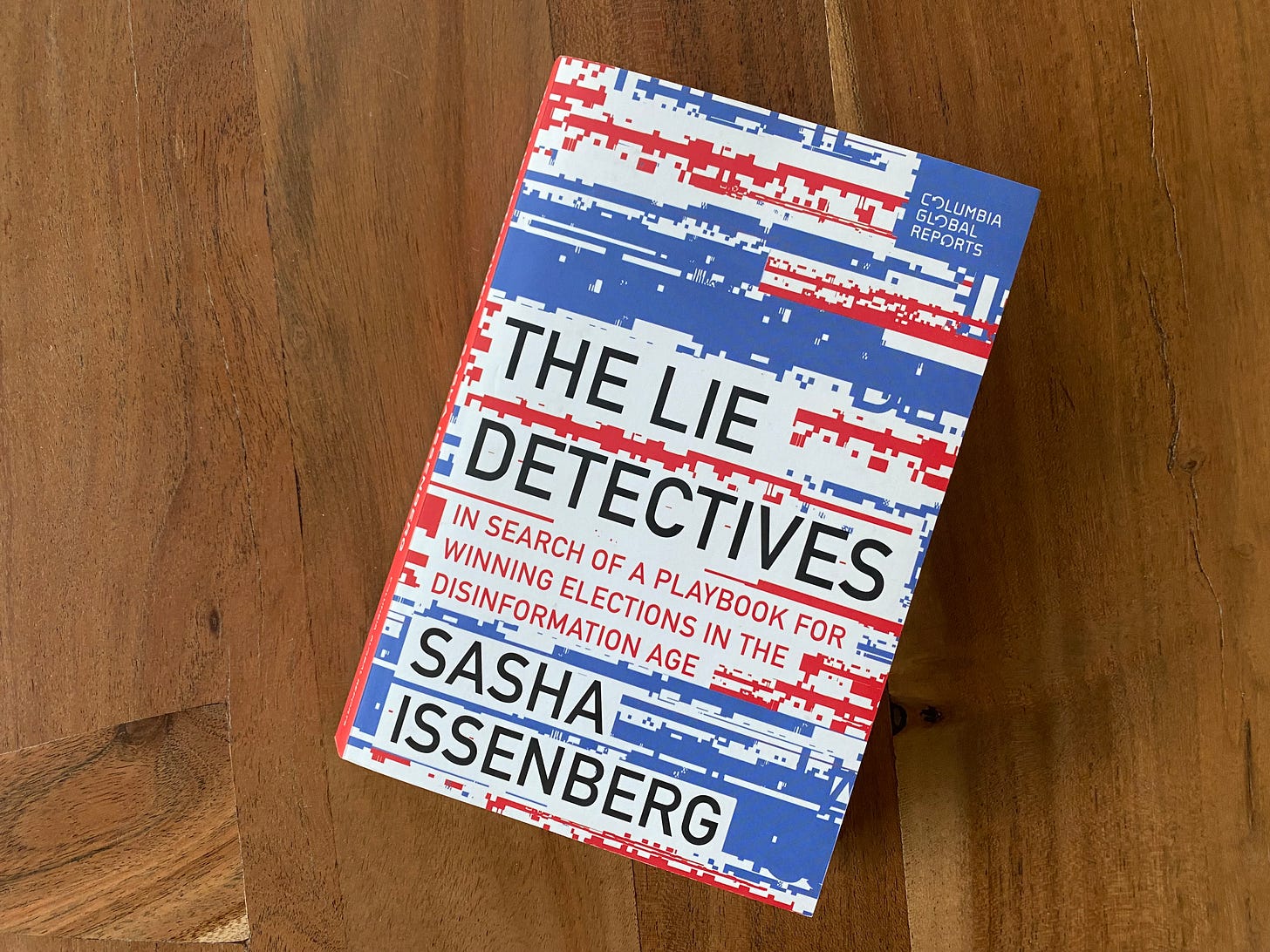Faked Up Summer Reading

The Death of Truth | Invisible Rulers | The Lie Detectives
Happy summer, Northern Hemisphere readers.
This special edition of Faked Up is brought to you by schedule send and the Mediterranean Sea. I am on holiday this week and next, but I hope you enjoy my reviews of three recent books about online deception.
There will be no newsletter next week; I’ll see you again on July 31.
The Death of Truth by Steven Brill (Random House — June 2024)

The Death of Truth is a frustrating piece of work.
NewsGuard co-founder Steven Brill’s book contains legitimate insights, but you’ll need to sift through generous servings of pedantry and petty takedowns to get to them.
Many of the book’s early chapters are secondary analysis that rely on sources like Aaron Sorkin’s The Social Network. A preference to cite the buzzy over the substantive is exemplified by Brill’s decision to spotlight the findings of Facebook whistleblower Frances Haugen over those of Sophie Zhang.
Brill bases most of his assessment of Trust & Safety efforts to combat misinformation on the opinion of an anonymous T&S worker he calls “Bob.” Based on Bob’s analysis, he concludes that my former function is more similar to an emergency room doctor than a scientist who works for Big Tobacco. Gee, thanks.
Another chapter is all about Mark Zuckerberg’s apologies, an exercise which has been done before and is not germane here. When The Death of Truth ventures beyond America, it is superficial and forgettable, mixing up the title of EU grandee Mariya Gabriel or remasticating the work of Carol Cadwalladr.
Then there’s the self-aggrandizing. In an early chapter, Brill says CNN called his organization “the librarian of the internet.” But the book’s own footnotes show this was Brill’s language, not that of then-CNN host Brian Stelter. Brill also says NewsGuard’s credibility scores are completely open access and that its work doesn’t lead to platform’s taking down content. Neither of this is fully true — which is OK! — but both claims are made with self-righteous swagger.
The book ignores or belittles most attempts to combat disinformation that aren’t things Brill came up with. He writes “the algorithms” apparently “really didn’t want to” catch misinformation, as if the many classifiers trained to do exactly that — flawed as they are — all met up over coffee and of their free will decided to do something else. Fact-checking efforts “were meant to assure regulators,” which may well be mostly true but is pretty rich from a man who has been actively lobbying Brussels decision-makers to require adoption of indicators like those NewsGuard provides.
The Death of Truth is strongest in the chapters about programmatic advertising. Brill is convincing and clear in showing how major brands ultimately prop up online dreck and misinformation through automated ad distribution. This should have been the core of a stronger and more focused book. I would have also gladly read more about the AI content farms that NewsGuard has been closely monitoring.
There are other interesting tidbits. It is newsworthy, if true, that Facebook’s Chief Product Officer Chris Cox told Brill “oh thank God, you can take us out of our misery” when first approached about NewsGuard. The book’s comparisons of the social engagement of pages it ranks as low-credibility versus high-credibility — for instances the DailySceptic.org vs. Full Fact — are a damning indictment of what trends on Facebook.
Brill also obviously deserves solidarity over the vile attacks he describes having received from pro-Kremlin propagandist John Dougan. NewsGuard was key in uncovering his tactics and its co-founder has been repaid with death threats he appears to be withstanding with aplomb and expensive security measures.
In line with the rest of the book, the chapter on solutions is a combination of naive, provocative and reasonable. Ending online anonymity is a terrible idea, in my opinion, but a nuanced discussion on authentication for credible sources is certainly worth having. Far greater disclosure of brand advertising and finding ways to make platform policies more legally applicable also feels reasonable.
Ultimately, a book called The Death of Truth was always going to rub me the wrong way. I have long been skeptical of “facts are dead” arguments — not because lies aren’t flooding our public spaces, but because it implies some kind of prior state where decisions were based only on science and propaganda did not exist.
Obviously, such a golden age doesn’t exist, but this framing is enduringly appealing to a particular brand of neoliberal boomers.
Brill writes that “over the last two decades we have seen the center eroded. The truths and trust shared by those in the center eroded too.” He claims that 9/11 united “much of the world.” This is both a very limited perspective of history and ironically oblivious to the conspiracy theories spawned by the terrorist attack.
As a book about the centrality of falsehoods in American society, The Death of Truth does not compare to Kurt Andersen’s excellent 2017 Fantasyland. As an overview of the tangled web of digital deception for profit, it fares a little better, but it is unlikely to become anyone’s reference book.
Invisible Rulers by Renée DiResta (Hachette — June 2024)

You’ve seen this book plenty in your feeds already. But have you bought it yet? I’m here to tell you that disinformation researcher Renee DiResta produced a voluminous but purchase-worthy tome.
DiResta argues, somewhat unconvincingly, that “this is not a book about social media.”
Even if it is less about platform mechanisms than about the evolving politics of communication, Invisible Rulers is also very much about Instagram, Rumble, Telegram, Twitter, YouTube and the rest of the merry bunch.
The book provides a historically-grounded analysis of the evolution of mass communication in 21st century America. It argues that top-down propaganda has crashed into grassroots rumor mills to produce a toxic hybrid. The result is that over and over, outspoken minorities can dictate the direction of discourse.
In an analogy she has made before, DiResta compares online crowds to murmurations of starlings. She writes that “today’s online crowds are extraordinarily influential participants; the flocks that careen around the social web both feed the algorithms and fish the influencers.”
Invisible Rulers is a brainy book that enlists not just Bernays, Lippmann and Chomsky but also less famous thinkers like Canetti, Katz and Lazarsfeld. Thanks to DiResta’s gift for a good turn of phrase and her tendency to call things by their name, the book can be fun as well as thoughtful. (I do think her Colosseum analogies fall flat, but a Roman would say that.)
DiResta’s chapter on COVID-19 misinformation may well be the definitive history of this phenomenon as it played out online in the United States. Her chapter on foreign influence operations is equally strong. Throughout, she draws heavily from her work at the Stanford Internet Observatory but pairs it with a historical understanding rooted in her origin story as a pro-vax California mom outgunned on social media.
The chapter on her own role in the “fantasy-industrial complex” has been amply covered, for example in pieces on The Atlantic, The New York Times and the interview below with The Washington Post’s Taylor Lorenz. It is depressing reading, even if the SCOTUS ruling on Murthy v Missouri has provided some post-publication relief (see FU#9 — “No Jawbones to Pick”).
I suspect that the “solutions” chapter was a request from DiResta’s publisher, because it didn’t quite click. The options were usually well-meaning but heavily-trodden shibboleths of the disinfo community I am a part of too, with the exception of ideas that DiResta has clearly spent time fleshing out before like a social media “circuit breaker.”
Invisible Rulers is a great book for both newbies and experts of this field, but it is not an optimistic one. DiResta writes that “The collision of the rumor mill and the propaganda machine can’t be undone.”
I appreciate that even while delivering this depressing verdict, DiResta avoids a nostalgic reinterpretation of America’s past as a place of truth. Throughout the book she compares the current disinformation wave to others in American history, especially with reference to the far-right propaganda of Father Coughlin. She notes:
There will be no return to a handful of media translating respectable institutional thinking for the masses. Nor should we pine for that: it is not immediately obvious that centralized lies pushed by the old power structure are preferable to the thousands of small lies pushed by the new. Chomsky’s critique of manufacturing consent was trenchant—and true. But the pervasive, acrimonious dissensus we find ourselves in is simply untenable for democratic society.
If there is a rallying cry in Invisible Rulers, it is that “networked institutions matter.” Knowledge-creating and fact-checking organizations must learn to coordinate and collectively contribute to discourse in the same way as malign influence operations. They might start by picking up a copy of DiResta’s book.
The Lie Detectives by Sasha Issenberg (Columbia Global Reports — March 2024)

In a booklet that is ultimately more about persuasion than deception, journalist Sasha Issenberg describes the reaction of political operatives to the misinformation-riddled Trump v Clinton 2016 presidential race.
This reaction, Issenberg writes, was “defined, and undertaken almost exclusively, by those in the ideological center and left” because the Trumpverse swiftly recast disinformation as a hoax and a cover for anti-conservative censorship.
Issenberg writes crisply and with wit (I chuckled at his aside that Senator Angus King and Burger King were not related). And he provides a valuable contribution in piecing together the collage of Democratic efforts to countenance another “fake news” fiasco, describing the role many organizations whose names were new to me as a Beltway outsider.
The Democrats’ effort to respond to “fake news” included a lot of trial-and-error, especially in the Alabama senatorial election of 2017. In a vote ultimately won by Democrat Doug Jones, a group of mostly Reid Hoffman-funded projects conducted gray operations targeting Republican candidate Roy Moore – some of which allegedly led to a reduction in turnout in State Senate districts.
These controversial efforts have been reported on before. But Issenberg makes a compelling – and to me novel — argument that the backlash against this experimentation led to shared standards among Democratic donors and campaigns that prohibited flat-out online deception.
Eventually, Democratic party operatives striving towards centralization built a disinformation-tracking consortium at the DNC. This became established enough in party operations that White House Chief of Staff Ron Klain relied on its assessments around big events.
Having introduced the governing arm of the Democratic Party in this way, I kept expecting the book to also address the DHS Disinformation Governance Board. The debacle around the Board came about because the Biden world’s overarching concern in losing the narrative war on migration due to online falsehoods was more than neutralized by his opponents’ capacity to recast the exercise as censorship.
The Lie Detectives would have been a sharper book if it concentrated exclusively on the American left’s response to online misinformation. Instead, Issenberg digresses into other communication mechanisms used to temper the electoral appeal of populists, including a chapter on memes. The examples from outside the United States, welcome in principle, also felt off-topic.
In a way, The Lie Detectives was bound to struggle sticking to the strictly anti-deceptive elements of the political battle against disinformation. The political — rather than academic or journalistic — incentive system was always not just to fight deception but also to win the argument and reduce the persuasiveness of your opponent. It’s why any fact-checker worth their title worries when politicians have Ideas to fight misinformation. Clean up your house first, goes the thinking.
And to his credit, Issenberg is acutely aware that in the political battle over disinformation, neither side is worried exclusively about getting to the truth. Here’s how he puts it, in one of the best parts of the book:
“Disinformation” became an outlet for all the free-floating anxieties related to passage into a new, unfamiliar environment. Unlike policymakers, political operatives were not really concerned with truth or falsity; they were perfectly at ease when the primary vectors of disinformation were senators or cable-news networks, whose sensibilities and pressure points they understood. But when their opponents were anonymous, placeless social-media accounts operating from ambiguous motivations they had little to offer. When they spoke about the vexing challenge of disinformation, they were acknowledging a newfound powerlessness. They had lost control of the means of communication.
I’d read a whole other book that — without falling into the trap of accepting the censorship argument — went way deep on the dual incentive system of campaigns that believe fighting disinformation is good politics as well as good policy.
Member discussion